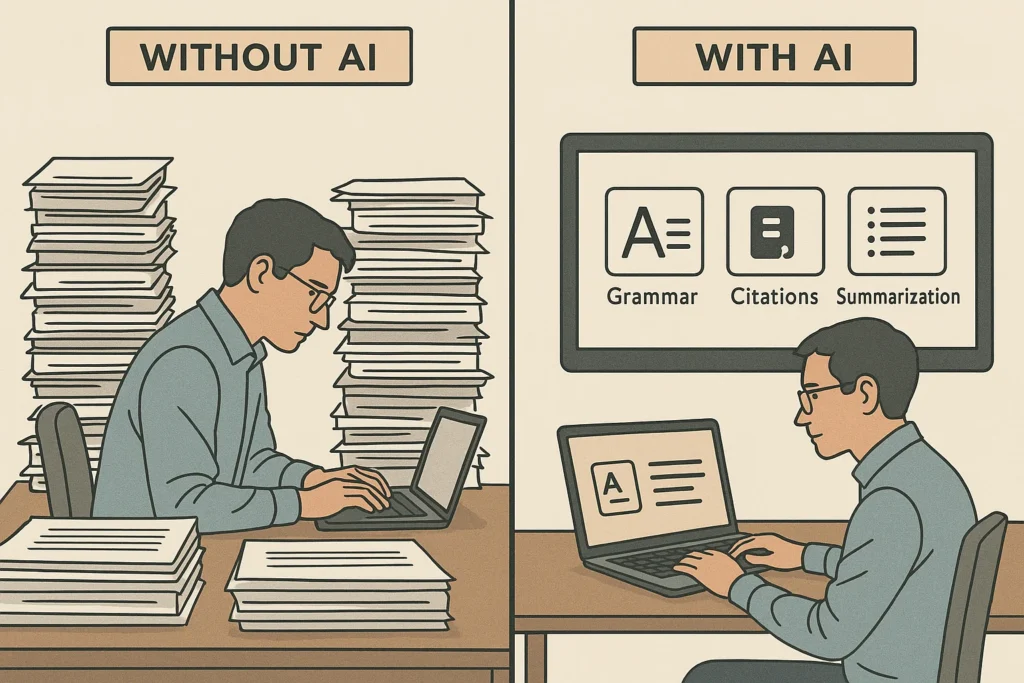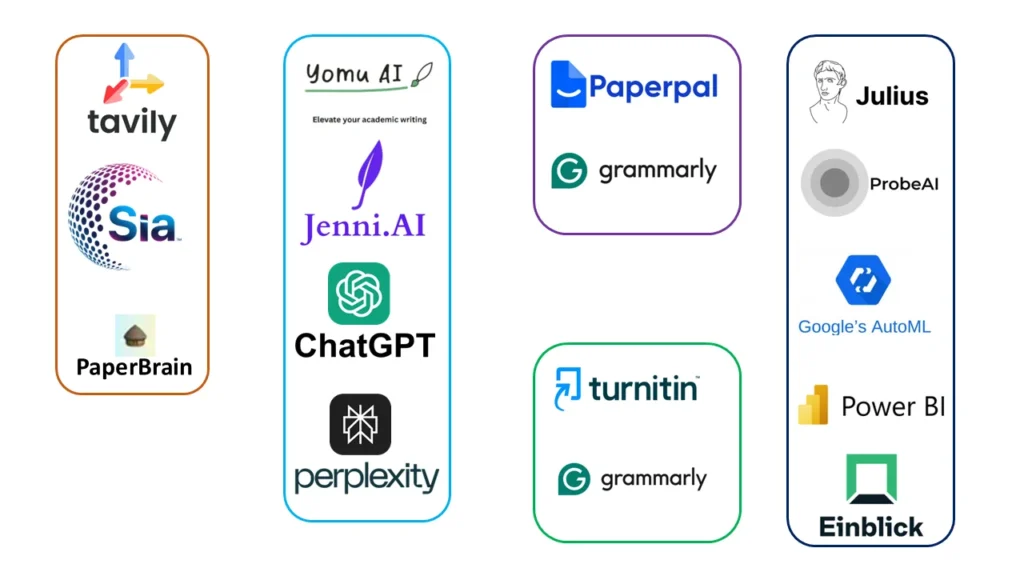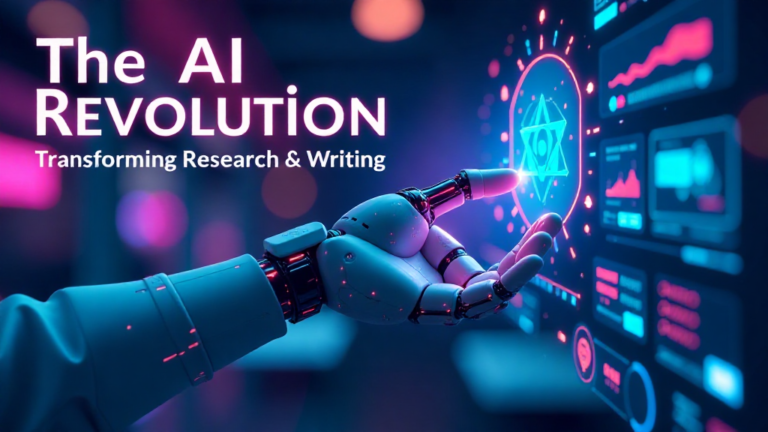AI Writing Tools for Research Papers: A 2025 Guide to Ethics & Efficiency
Navigate the New Era of Research: A Strategic Guide to AI Writing Tools in 2025
The academic landscape is shifting beneath our feet. Are AI writing tools for research papers your secret weapon for unprecedented productivity, or a fast track to compromised credibility? This essential 2025 guide cuts through the hype to deliver the undeniable truth. We reveal which tools are genuinely useful, expose their critical limitations, and provide the ethical framework you need to harness AI’s power without sacrificing your academic integrity. Stop wondering and start navigating with confidence.
Table of Contents
In 2025, the academic world is grappling with a monumental shift. Artificial intelligence (AI) is no longer a futuristic fantasy but a present reality, and it’s changing the way research papers are written. Are you ready to face the truth? This post unveils the crucial facts about AI vs. human writing in research papers, revealing what you need to know to navigate this evolving landscape.
AI writing tools for research papers: Friend or Foe to Academic Integrity?
AI writing tools promise to revolutionize research, offering enhanced productivity, grammar and style assistance, and even help with complex tasks like literature reviews. Features such as language suggestions, grammar checks, paraphrasing, summarization, and citation management can appear to streamline the writing process significantly. But are these tools a boon or a threat to academic integrity?

AI Writing Tools: Separating Fact from Fiction
Here’s a closer look at some of the most popular AI writing tools and a realistic assessment of their capabilities:

- Yomu AI: Assists with research papers, citations, and academic writing structure.
- Writefull Academizer: Enhances academic writing through proofreading and paraphrasing.
- Paperpal: Provides language suggestions and academic writing improvements.
- SciSpace Paraphraser: Enhances clarity and originality through paraphrasing.
- ChatGPT: Assists with structure, clarity, and writing improvement.
- Wordvice.ai: AI-powered academic writing assistant.
- Jenni AI: Offers AI-powered paraphrasing, citations, and plagiarism detection.
- Elephas: AI-powered writing tool with citation management.
- Quillbot: Helps with paraphrasing and language enhancement.
- LumenWriter: Assists with research organization and content generation.
- Jasper (formerly Jarvis): Helps structure research writing and generate content.
The Uncomfortable Truth: AI’s Limitations and Potential Pitfalls
- Authenticity in Question: AI-generated text is harder to distinguish from human writing, raising concerns about credibility.
- Lack of Nuance and Originality: AI lacks deep critical thinking and originality in academic writing.
- Ethical Concerns: Transparency in AI usage is essential to maintain academic integrity.
- Dependence Threat: Over-reliance on AI can stifle independent critical thinking.
- Quality Concern: AI-generated abstracts often lack depth and contain generic statements.
- Human Essentiality: Peer review, originality, and subjective insights remain crucial in academic writing.
Special Section: AI Giants – ChatGPT, Perplexity AI, DeepSeek, and Beyond
- ChatGPT: Great for formatting and improving clarity but requires human oversight.
- Perplexity AI: Provides sourced, accurate information, making it ideal for research.
- DeepSeek: A powerful AI model capable of complex text analysis but still requires human evaluation.
Quick Comparison Table
| Tool | Language Enhancement | AI Proofreading | Citation Management | Paraphrasing | Summarization |
|---|---|---|---|---|---|
| Yomu AI | ✓ | ✓ | ✓ | ✓ | ✓ |
| Writefull Academizer | ✓ | ✓ | ✓ | ||
| Paperpal | ✓ | ✓ | ✓ | ||
| SciSpace Paraphraser | ✓ | ✓ | |||
| Wordvice.ai | ✓ | ✓ | ✓ | ✓ | |
| Jenni AI | ✓ | ✓ | ✓ | ✓ |
How AI writing tools for research papers are Changing Academic Writing: Watch the Full Video
For a deeper dive into AI writing tools for research papers, check out our latest YouTube video. It covers:
- How AI is being used in academic writing
- The top AI tools categorized by purpose
- Key features that make these tools essential
- Ethical concerns and plagiarism risks
- The future of AI writing tools for research papers
The Path Forward: Collaboration, Not Replacement
- Use AI as a Tool, Not a Crutch: Enhance your writing, don’t replace your creativity.
- Focus on Higher-Level Skills: Develop critical thinking and synthesis abilities.
- Uphold Ethical Standards: Maintain transparency in AI-assisted work.
- Value Authenticity: Originality and unique thought remain irreplaceable.
The Broader Revolution: How AI is Redefining Academia
To fully understand the impact of AI writing tools for research papers, it’s essential to see them as part of a much larger transformation. AI is not just changing how we write papers; it’s fundamentally reshaping the entire research lifecycle—from hypothesis generation and data analysis to peer review.
In our deep dive, The Revolution of AI in Research and Writing: Redefining Academia, we explore this seismic shift in detail. That article goes beyond writing tools to examine:
AI-Powered Discovery: How algorithms are helping researchers identify gaps in the literature and formulate novel research questions.
Data Analysis at Scale: The role of AI in processing vast datasets, uncovering patterns that would be impossible for humans to find manually.
The Future of Peer Review: Exploring how AI is beginning to assist in the initial screening of manuscripts for quality and plagiarism.
The Evolving Role of the Researcher: How the academic’s focus is shifting from manual tasks to high-level interpretation, critique, and intellectual synthesis.
Think of it this way: The AI writing tools for research papers discussed in this article are the spearhead of a much larger invasion. They are the most visible and widely used applications of AI in academia today. To get the full picture of the forces reshaping your field, understanding the broader revolution is essential.
Continue reading: The Revolution of AI in Research and Writing
Conclusion: Master the Tools, Uphold the Craft
The future of research isn’t about humans versus AI; it’s about humans empowered by AI. Tools like ChatGPT and Perplexity AI offer unprecedented assistance, but the core of academic work—critical thought, original insight, and ethical rigor—remains irreplaceably human. Your role is evolving from a sole writer to a strategic director: leveraging AI for efficiency while applying your expertise to validate, refine, and elevate the work. Embrace these tools wisely, use them transparently, and let your unique intellect guide the way.
FAQs on AI writing tools for research papers
Can AI writing tools for research papers generate an entire manuscript?
Technically, yes, advanced models can generate a full text. However, it is highly discouraged and considered a serious breach of academic integrity. AI-generated papers often lack original thought, critical analysis, and depth, and they can be detected by AI plagiarism software, leading to severe academic penalties.
What is the most ethical way to use AI writing tools for research papers?
Use AI as a research assistant, not a ghostwriter. Ethical uses include: brainstorming ideas, improving the grammar and clarity of your own writing, summarizing complex sources you’ve already read, and helping to manage and format your citations. Always disclose the use of these tools if required by your institution.
Which of the AI writing tools for research papers is best for finding and summarizing academic sources?
For this specific task, Perplexity AI is highly recommended. It excels at providing sourced, factual answers and can summarize information from recent and credible publications, making it an ideal starting point for literature reviews.
How can I tell if a research paper was written by AI?
Look for generic phrasing, a lack of deep critical insight, superficial analysis, and perfectly structured but ultimately hollow arguments. AI text often “sounds” correct but fails to deliver novel concepts or nuanced discussion. Universities are increasingly using detection software to identify these hallmarks in suspect documents.
Is using an AI paraphrasing tool like Quillbot considered plagiarism?
It can be. If you use a tool to paraphrase someone else’s ideas or text without proper citation, it is a form of plagiarism. The ethical approach is to use these tools to rephrase your own drafted ideas for better clarity and flow, not to avoid citing sources.
What are the biggest risks of relying on AI writing tools for research papers?
The primary risks are:
1) Stifling Your Critical Thinking: Over-reliance prevents you from developing essential research and analytical skills.
2) Factual Inaccuracy: AI can “hallucinate” and present false information confidently.
3) Academic Misconduct: Undisclosed use can lead to accusations of plagiarism and cheating.
4) Generic Output: AI-generated content often lacks the originality and depth required for high-quality research.
Do I need to cite ChatGPT or other AI writing tools for research papers?
Citation standards are still evolving, but major style guides like APA, MLA, and Chicago now provide formats for citing AI-generated content. When in doubt, transparency is best. You should cite the AI tool whenever you use its output directly or indirectly, and check your institution’s specific policy.






2 Comments